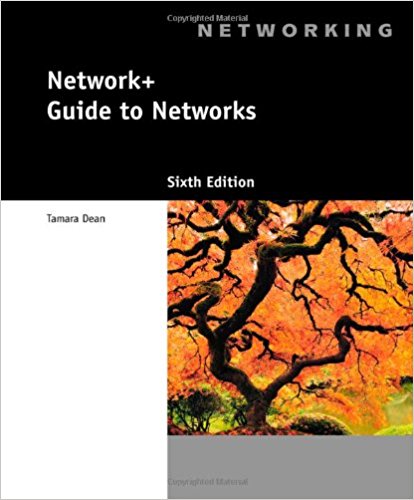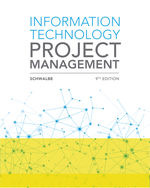Description
Test Bank For Network + Guide to Networks 6th Edition by Tamara Dean
Chapter 3: Transmission Basics and Networking Media
TRUE/FALSE
1.The strength of an electrical signal is directly proportional to its frequency.
ANS: F PTS: 1 REF: 77
2.Modulation can be used to make a signal conform to a specific pathway.
ANS: T PTS: 1 REF: 82
3.Ethernet is an example of a baseband system found on many LANs.
ANS: T PTS: 1 REF: 89
4.Latency occurs when a signal traveling on one wire or cable infringes on the signal traveling over an adjacent wire or cable.
ANS: F PTS: 1 REF: 90
5.The maximum distance a signal can travel and still be interpreted accurately is equal to a segment’s maximum length.
ANS: T PTS: 1 REF: 95
MULTIPLE CHOICE
1.The distance between corresponding points on a wave’s cycle is called its ____.
|
a. |
amplitude |
c. |
phase |
|
b. |
frequency |
d. |
wavelength |
ANS: D PTS: 1 REF: 78
2.A digital signal composed of a pulse of positive voltage represents a(n) ____.
|
a. |
0 |
c. |
4 |
|
b. |
1 |
d. |
8 |
ANS: B PTS: 1 REF: 79
3.The byte 00001110 means ____ on a digital network.
|
a. |
3 |
c. |
14 |
|
b. |
6 |
d. |
30 |
ANS: C PTS: 1 REF: 79
4.In modulation, a simple wave called a(n) ____ wave, is combined with another analog signal to produce a unique signal that gets transmitted from one node to another.
|
a. |
carrier |
c. |
information |
|
b. |
data |
d. |
FM |
ANS: A PTS: 1 REF: 82
5.When signals are free to travel in both directions over a medium simultaneously, the transmission is considered ____.
|
a. |
simplex |
c. |
half-duplex |
|
b. |
multiplex |
d. |
full-duplex |
ANS: D PTS: 1 REF: 83
6.____ is a technology used with fiber-optic cable, which enables one fiber-optic connection to carry multiple light signals simultaneously.
|
a. |
Statistical multiplexing |
|
b. |
WDM (wavelength division multiplexing) |
|
c. |
TDM (time division multiplexing) |
|
d. |
FDM (frequency division multiplexing) |
ANS: B PTS: 1 REF: 86
7.The data transmission characteristic most frequently discussed and analyzed by networking professionals is ____.
|
a. |
noise |
c. |
throughput |
|
b. |
scalability |
d. |
cost |
ANS: C PTS: 1 REF: 88
8.One of the most common transmission flaws affecting data signals is ____.
|
a. |
noise |
c. |
throughput |
|
b. |
attenuation |
d. |
latency |
ANS: A PTS: 1 REF: 90
9.The most significant factor in choosing a transmission method is its ____.
|
a. |
noise |
c. |
throughput |
|
b. |
attenuation |
d. |
latency |
ANS: C PTS: 1 REF: 93
10.The more twists per foot in a pair of wires, the more resistant the pair will be to ____.
|
a. |
throughput |
c. |
cross talk |
|
b. |
attenuation |
d. |
latency |
ANS: C PTS: 1 REF: 99
11.Modern LANs use ____ or higher wiring.
|
a. |
Cat 3 |
c. |
RG-6 |
|
b. |
Cat 5 |
d. |
RG-59 |
ANS: B PTS: 1 REF: 100
12.Serial refers to a style of data transmission in which the pulses that represent bits follow one another along a ____ transmission line.
|
a. |
long |
c. |
secondary |
|
b. |
short |
d. |
single |
ANS: D PTS: 1 REF: 113-114
13.____ describes a popular serial data transmission method.
|
a. |
EIA/TIA Commercial Building Wiring Standard |
|
b. |
EIA/TIA RS-232 (Recommended Standard 232) |
|
c. |
EIA/TIA 568A standard |
|
d. |
EIA/TIA 568BA standard |
ANS: B PTS: 1 REF: 114
14.Which connector is used in RS-232 transmissions?
|
a. |
DB-25 |
c. |
BNC |
|
b. |
ST |
d. |
Cat-5 |
ANS: A PTS: 1 REF: 114
15.The serial interface on the back of the connectivity device is often labeled “____.”
|
a. |
Connector |
c. |
Board |
|
b. |
Port |
d. |
Console |
ANS: D PTS: 1 REF: 115
16.Which term describes the hardware that makes up the enterprise-wide cabling system?
|
a. |
wiring board |
c. |
network diagram |
|
b. |
patch panel |
d. |
cable plant |
ANS: D PTS: 1 REF: 116
17.Which standard is also known as structured cabling?
|
a. |
TIA/EIA Commercial Building Wiring Standard |
|
b. |
TIA/EIA RS-232 (Recommended Standard 232) |
|
c. |
TIA/EIA 568A Standard |
|
d. |
TIA/EIA 568BA Standard |
ANS: A PTS: 1 REF: 116
18.The points where circuits interconnect with other circuits is known as ____.
|
a. |
entrance facilities |
c. |
IDF (intermediate distribution frame) |
|
b. |
cross-connect facilities |
d. |
telecommunications closet |
ANS: B PTS: 1 REF: 117
19.Which term identifies a room containing connectivity for groups of workstations in its area?
|
a. |
MDF (main distribution frame) |
c. |
work area |
|
b. |
entrance facilities |
d. |
telecommunications closet |
ANS: D PTS: 1 REF: 119
20.____ describes wiring that connects workstations to the closest telecommunications closet.
|
a. |
Backbone wiring |
c. |
Work area |
|
b. |
Horizontal wiring |
d. |
Simple wiring |
ANS: B PTS: 1 REF: 119
21.Many network problems can be traced to poor cable ____ techniques.
|
a. |
manufacturing |
c. |
installation |
|
b. |
engineering |
d. |
planning |
ANS: C PTS: 1 REF: 120
COMPLETION
1.The use of 1s and 0s to represent information is characteristic of a(n) ____________________ system.
ANS: binary
PTS: 1 REF: 79
2.____________________ is a term used by networking professionals to describe the nondata information that must accompany data for a signal to be properly routed and interpreted by the network.
ANS: Overhead
PTS: 1 REF: 81
3. ____________________ transmission involves one transmitter and multiple receivers.
ANS: Point-to-multipoint
PTS: 1 REF: 87
4.____________________ are the pieces of hardware that connect the wire to the network device.
ANS: Connectors
PTS: 1 REF: 95
5.____________________ cabling consists of one or more insulated wire pairs encased in a plastic sheath.
ANS:
UTP (unshielded twisted pair)
Unshielded twisted pair
UTP
PTS: 1 REF: 101
MATCHING
Match each item with a statement below:
|
a. |
bit |
f. |
populated segment |
|
b. |
data modulation |
g. |
unpopulated segment |
|
c. |
baseband |
h. |
broadband |
|
d. |
EMI (electromagnetic interference) |
i. |
nonbroadcast |
|
e. |
broadcast |
||
1.Transmission that involves one transmitter and multiple, undefined receivers.
2.Transmission that issues signals to multiple, defined recipients.
3.Transmission form in which (typically) digital signals are sent through direct current (DC) pulses applied to the wire.
4.Part of a network that contains end nodes.
5.A common source of noise.
6.Every pulse in a digital signal.
7.Part of the network that does not contain end nodes.
8.A form of transmission in which signals are modulated as radio frequency (RF) analog waves that use different frequency ranges.
9.Technology used to modify analog signals to make them suitable for carrying data over a communication path.
1.ANS:EPTS:1REF:87
2.ANS:IPTS:1REF:87
3.ANS:CPTS:1REF:89
4.ANS:FPTS:1REF:95
5.ANS:DPTS:1REF:90
6.ANS:APTS:1REF:79
7.ANS:GPTS:1REF:95
8.ANS:HPTS:1REF:89
9.ANS:BPTS:1REF:82
SHORT ANSWER
1.Describe a drawback of analog signals.
ANS:
One drawback to analog signals is that their voltage is varied and imprecise. Thus, analog transmission is more susceptible to transmission flaws such as noise, or any type of interference that may degrade a signal, than digital signals.
PTS: 1 REF: 79
2.Describe two benefits of digital signaling that make it worthwhile even though extra signaling pulses are involved.
ANS:
Because digital transmission involves sending and receiving only a pattern of 1s and 0s, represented by precise pulses, it is more reliable than analog transmission, which relies on variable waves. In addition, noise affects digital transmission less severely.
PTS: 1 REF: 81
3.Explain how half-duplex transmissions work.
ANS:
In half-duplex transmission, signals may travel in both directions over a medium but in only one direction at a time. Half-duplex systems contain only one channel for communication, and that channel must be shared for multiple nodes to exchange information.
PTS: 1 REF: 83
4.Describe what FDM (frequency division multiplexing) is and how it works.
ANS:
FDM (frequency division multiplexing) is a type of multiplexing that assigns a unique frequency band to each communications subchannel. Signals are modulated with different carrier frequencies, then multiplexed to simultaneously travel over a single channel. The first use of FDM was in the early 20th century when telephone companies discovered they could send multiple voice signals over a single cable. That meant that rather than stringing separate lines for each residence (and adding to the urban tangle of wires), they could send as many as 24 multiplexed signals over a single neighborhood line. Each signal was then demultiplexed before being brought into the home.
PTS: 1 REF: 85-86
5.Describe variables that may influence the final cost of implementing a certain type of media.
ANS:
The following variables can all influence the final cost of implementing a certain type of media:
· Cost of installation – Can you install the media yourself, or must you hire contractors to do it? Will you need to move walls or build new conduits or closets? Will you need to lease lines from a service provider?
· Cost of new infrastructure versus reusing existing infrastructure – Can you use existing wiring? In some cases, for example, installing all new Category 6 UTP wiring may not pay off if you can use existing Category 5 UTP wiring. If you replace only part of your infrastructure, will it be easily integrated with the existing media?
· Cost of maintenance and support – Reuse of an existing cabling infrastructure does not save any money if it is in constant need of repair or enhancement. Also, if you use an unfamiliar media type, it may cost more to hire a technician to service it. Will you be able to service the media yourself, or must you hire contractors to service it?
· Cost of a lower transmission rate affecting productivity – If you save money by reusing existing slower lines, are you incurring costs by reducing productivity? In other words, are you making staff wait longer to save and print reports or exchange e-mail?
· Cost of downtime—If a cabling system is poorly installed and needs fixing, or if an inexpensive solution needs to be replaced in just a few years, at least some of your organization’s users will not be able to work. Even at a small office, a few hours of downtime can cost a business several thousand dollars in lost productivity. For an organization that relies on its network for taking orders or providing services, the toll could be much higher.
· Cost of obsolescence – Are you choosing media that may become passing fads, requiring rapid replacement? Will you be able to find reasonably priced connectivity hardware that will be compatible with your chosen media for years to come?
PTS: 1 REF: 93-94
6.Explain the makeup of coaxial cable.
ANS:
Coaxial cable consists of a central metal core (often copper) surrounded by an insulator, a braided metal shielding, called braiding or shield, and an outer cover, called the sheath or jacket. The core may be constructed of one solid metal wire or several thin strands of metal wire. The core carries the electromagnetic signal, and the braided metal shielding acts as both a shield against noise and a ground for the signal. The insulator layer usually consists of a plastic material such as PVC (polyvinyl chloride) or Teflon. It protects the core from the metal shielding, because if the two made contact, the wire would short-circuit. The sheath, which protects the cable from physical damage, may be PVC or a more expensive, fire-resistant plastic.
PTS: 1 REF: 96-97
7.Explain the makeup of twisted pair wire.
ANS:
Twisted pair cable consists of color-coded pairs of insulated copper wires, each with a diameter of 0.4 to 0.8 mm (approximately the diameter of a straight pin). Every two wires are twisted around each other to form pairs, and all the pairs are encased in a plastic sheath. The number of pairs in a cable varies, depending on the cable type.
PTS: 1 REF: 99
8.Describe the advantages of twisted pair wiring.
ANS:
Twisted pair cable is relatively inexpensive, flexible, and easy to install, and it can span a significant distance before requiring a repeater (though not as far as coax). Twisted pair cable easily accommodates several different topologies, although it is most often implemented in star or star-hybrid topologies. All twisted pair cable falls into one of two categories: STP (shielded twisted pair) or UTP (unshielded twisted pair).
PTS: 1 REF: 100
9.Explain the makeup of fiber-optic cable.
ANS:
Fiber-optic cable, or simply fiber, contains one or several glass or plastic fibers at its center, or core. Data is transmitted via pulsing light sent from a laser (in the case of 1- and 10-Gigabit technologies) or an LED (light-emitting diode) through the central fibers. Surrounding the fibers is a layer of glass or plastic called cladding. The cladding has a different density from the glass or plastic in the strands. It reflects light back to the core in patterns that vary depending on the transmission mode. This reflection allows the fiber to bend around corners without diminishing the integrity of the light-based signal. Outside the cladding, a plastic buffer protects the cladding and core. Because the buffer is opaque, it also absorbs any light that might escape. To prevent the cable from stretching, and to protect the inner core further, strands of Kevlar (a polymeric fiber) surround the plastic buffer. Finally, a plastic sheath covers the strands of Kevlar.
PTS: 1 REF: 108-109
10.Describe the benefits of fiber-optic cabling over copper cabling.
ANS:
Fiber-optic cable provides the following benefits over copper cabling:
• Extremely high throughput
• Very high resistance to noise
• Excellent security
• Ability to carry signals for much longer distances before requiring repeaters than copper cable
• Industry standard for high-speed networking
PTS: 1 REF: 109-110





Be the first to review “Test Bank For Network + Guide to Networks 6th Edition by Tamara Dean”